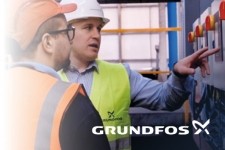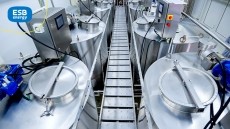Factory of the future

One inevitable result of the recession is that fewer factories are being built than a decade ago. Cash and credit have become scarcer, meaning food manufacturers are more cautious when it comes to investing in new plants.
"There has been a massive cutback in spend on new builds," says Mark Schubert, director of food management consultancy Coriolis. "Manufacturers are trying to get more out of what they have got, so we are finding more consolidation of sites. There has been a massive cutback in spend on new builds."
While there have been some new factories in the past two years Greggs opened a confectionery bakery in Penrith, Elizabeth the Chef invested in a factory in Leamington Spa, and Hazeldean Foods converted an existing building to a new salad factory in Wigan consolidation in the food industry inevitably means many factories are being closed.
Where venture capitalists have taken a stake in food businesses, long-term investment plans are rare. "Venture capitalists want one-year paybacks or sometimes three-year paybacks but they don't look further than that because they want to make a few bucks," says Mike Roberts, project director at Coriolis.
However, for stable companies planning ahead and investing in factories, future-proofing is becoming an ever-pressing concern. They need facilities that will grow as they do with minimal disruption to operations.
Wingland Foods
Wingland Foods in Sutton Bridge, Lincolnshire is one such factory. The Bakkavör-owned plant has been extended four times in its 13-year life. Since it opened in 1999, its footprint has increased from 4,759m2 to 6,683m2.
The factory, which manufactures salads exclusively for Waitrose, has grown with the retailer and expanded the range of products it makes from just bagged salads to trays and pots plus a range of deli salads. However, the future-proof original design means disruption to the plant during these extensions has been minimal, with very little downtime and no major machinery movements.
Future-proofing is a major concern for firms in a position to invest. "New build factories are not as common today as they were 10 years ago because there has been a lot of rationalisation in the industry," says Jo Willis, md of Arctica, the firm of architects behind the Wingland Foods factory, that also counts Northern Foods, Greggs, Tyrells, Noble Foods and Elizabeth the Chef as clients. "More factories have closed than opened in the past five or six years."
The design of the Bakkavör factory is based on a central spine, from which new areas can be built without disrupting the activities of the existing factory. Jacqui Green, general manager of Wingland Foods, says the extensions have been "bolted on to either side of that spine. It is modular. You can build a factory within a factory and literally knock a hole in the wall the day you want to finish it off, so it has been fairly seamless".
The first extension was in 2001, which involved increasing the factory's dispatch area by 150%; the second was in 2005, increasing the deli area by 75%; the third was in 2006, adding another 100% of floor space to the deli salad assembly area; and in 2011 the biggest extension was completed, expanding the area for cooking ingredients such as cous cous, roasted vegetables and pasta with £100,000 worth of new equipment.
Although there are no current plans to further extend Wingland Foods, Green says it is likely another extension will be needed in the future. "Waitrose is growing faster than any other supermarket and there will almost certainly be the need for expansion, be that in terms of footprint or equipment," she says. "We are all very clear that Waitrose is going to continue to grow and we will grow with them."
Dairy Crest
Future-proofing was also an important consideration for Dairy Crest, when it extended its cold store at Foston, Derbyshire last year. The extension was completed in December. Coriolis managed the project, which involved extending the existing building and creating five additional loading docks. "One of the remits was to future-proof the building for further expansion so we put in a first floor area that could be linked to any further expansion," says Roberts. "We created a mezzanine steel structure that would link any future buildings should Dairy Crest decide to expand. If they do decide to extend the building any further to make it into a distribution centre rather than just a coldstore then we won't be limiting ourselves."
Coriolis is also currently working with a food ingredients manufacturer in Finland, where future proofing has been built into the design. The manufacturer uses fermentation tanks to produce enzymes for food ingredients. "We are putting in spaces during the construction work for additional tanks that will be used in forthcoming years," explains Schubert.
Inevitably while many larger manufacturers plan ahead, the upsurge in acquisitions of smaller businesses means Arctica is asked to work on factories that haven't been so thoughtfully planned. "On a lot of projects where we are altering or extending existing buildings we come across the recurrent problem of lean-to extensions all around the existing factory," says Willis. "Those lean-tos are usually full of expensive plant room equipment, refrigeration equipment and compressed air equipment, and you can't expand the building because what had been a very economical installation years before is now sitting in the way of any future flexibility.
"Where we get the opportunity on a major project to future proof it, we try to keep areas free," adds Willis. "We put it all over the drawings this area is sacred, keep clear so future proofing can be built in to a project from day one."
Machinery maintenance saves your business money
With fewer factories being built now than a decade ago, getting the most out of existing factories through regular maintenance is becoming increasingly important. Ensuring machinery is running at its most energy efficient can save enormous sums of money over the lifetime of the factory.
Coriolis recently worked with a large food group in Hamburg where the installation of a cooling tower had been done incorrectly. "We worked with specialist utilities engineers to correct it," says Schubert. "Because it wasn't working they were putting more waste into effluent treatment, which was causing problems and more pollution into the air in the centre of Hamburg, which was extremely problematic. We increased their capacity and reduced their impact on the environment."
Routine maintenance is also essential, says Green, and is something Bakkavör takes seriously. "We have a planned preventative maintenance (PPM) system with engineers that work in teams so we have electronic engineers, fabrication engineers and general skilled engineers, so there is a broad skillbase. With a PPM system, the maintenance happens no matter what, so if the sun is shining and the demand for salads goes crazy that is exactly the time to hold your nerve and go with your PPM schedule because it is at that time a machine gets a lot of abuse and it could go wrong.
"A PPM system is not 'a nice to have', it is absolutely crucial."
Schubert says the number of acquisitions in the food industry in recent years means he has worked with some factories, recently bought out by larger groups, where inefficient processes and poor maintenance schedules are ingrained into the business. "There are a lot of businesses that have been doing the same thing for such a long time they often do it parrot fashion. It is getting people to understand what operational efficiency is. What is efficiency? What is productivity? What is yield? It sounds ridiculous but they are fundamentals that aren't often ingrained in operational knowledge."
For example, this means making sure the equipment is not being overused. "If you have got a business that makes pies in large ovens, if the process is inefficient you use the ovens more," says Schubert. "Now if you improve the efficiencies, you use the ovens less and therefore you use less energy."
This was the case at the Trebor Basset factory in Sheffield, which called in technical specialist Brammer to review energy use back in 2010. The gum stoves, part of the jelly baby process, were identified as an area where the specification of more energy efficient components would cut costs and reduce emissions.
Brammer developed a revised, more energy efficient specification and, after the new equipment was successfully trialled on four of the stoves, all 13 gum stoves were upgraded. Brammer replaced the two 11kW motors in each stove and replaced them with more efficient and equally effective 4kW motors. The standard V belts were replaced with synchronous drive belts and the motors improved their energy efficiency with the installation of a variable speed drive to each stove. This increased process speed control, and improved the effectiveness of the production process. "It translates into a £59,500 cost saving as well as being great for the environment," says Tim Jeffries, chief engineer at the Sheffield factory.
















